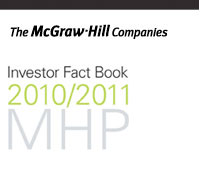The McGraw-Hill Companies (NYSE: MHP) is a leading global education and financial information company that plays a crucial
role in the knowledge economy with leading brands such as Standard & Poor’s, McGraw-Hill Education, Platts energy information services, and J.D. Power and Associates.
The annual Investor Fact Book contains in-depth information on MHP’s performance and trends that underpin the growth of its key businesses
in education, financial services, and information markets.
Chairman, President and
Chief Executive Officer
Executive Vice President
and Chief Financial Officer
Executive Vice President
and Chief Information Officer
Executive Vice President
Human Resources
Executive Vice President,
Corporate Affairs and
Executive Assistant to the
Chairman, President and CEO
Executive Vice President
Global Strategy
Executive Vice President and
General Counsel
President
McGraw-Hill Education
President
Standard & Poor’s
President
McGraw-Hill Financial
President
Information & Media
of 1995
Actual results may differ materially from those in any forward-looking statements because any such statements involve risks and uncertainties and are subject to change based upon various important factors, including, but not limited to, worldwide economic, financial, political and regulatory conditions; currency and foreign exchange volatility; the health of debt and equity markets, including interest rates, credit quality and spreads, the level of liquidity, future debt issuances including, corporate issuance, residential and commercial mortgage-backed securities and CDO’s backed by residential mortgages, related asset classes and other asset-backed securities; the implementation of an expanded regulatory scheme affecting Standard & Poor’s ratings and services; the level of funding in the education market (both domestically and internationally); the pace of recovery in advertising; continued investment by the construction, automotive, computer and aviation industries; the successful marketing of new products, and the effect of competitive products and pricing.
